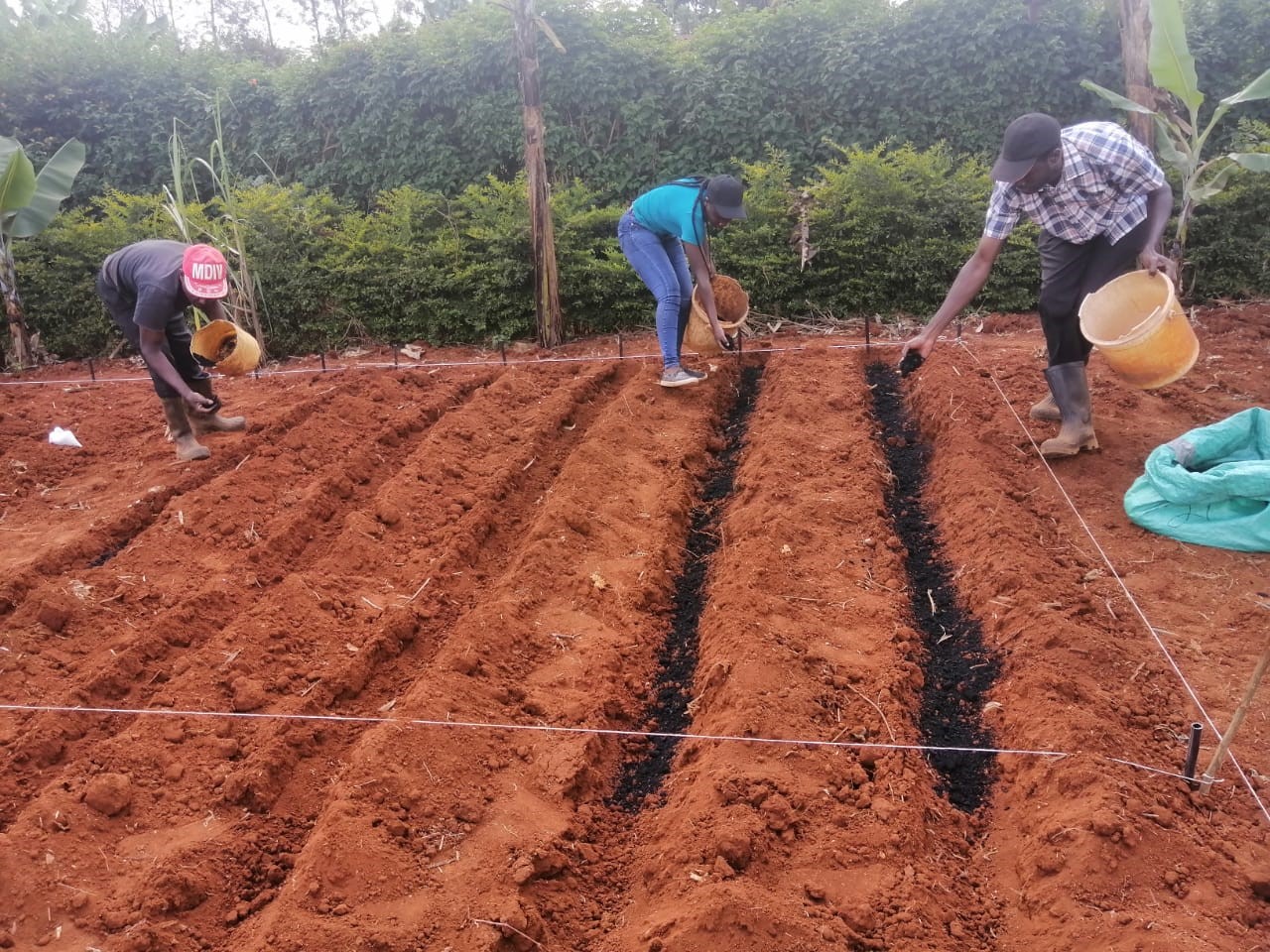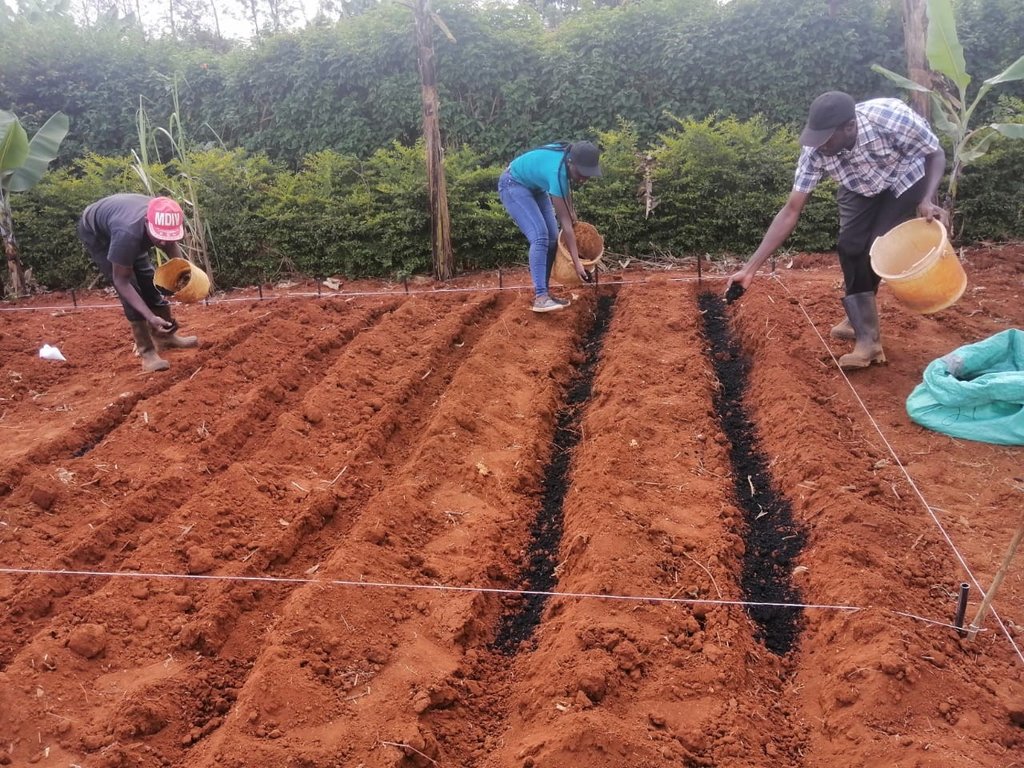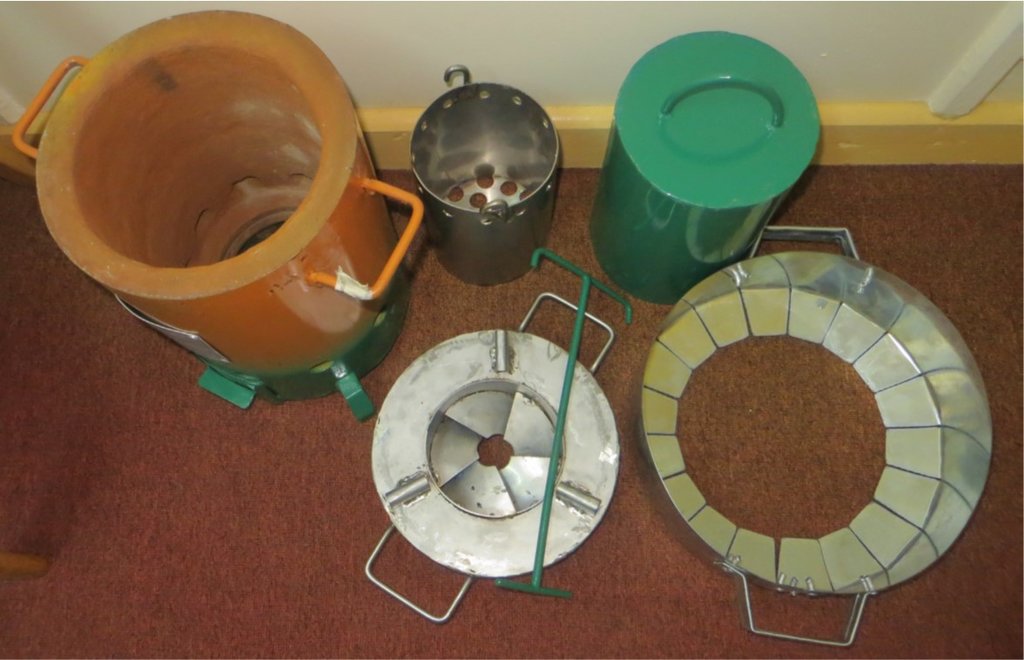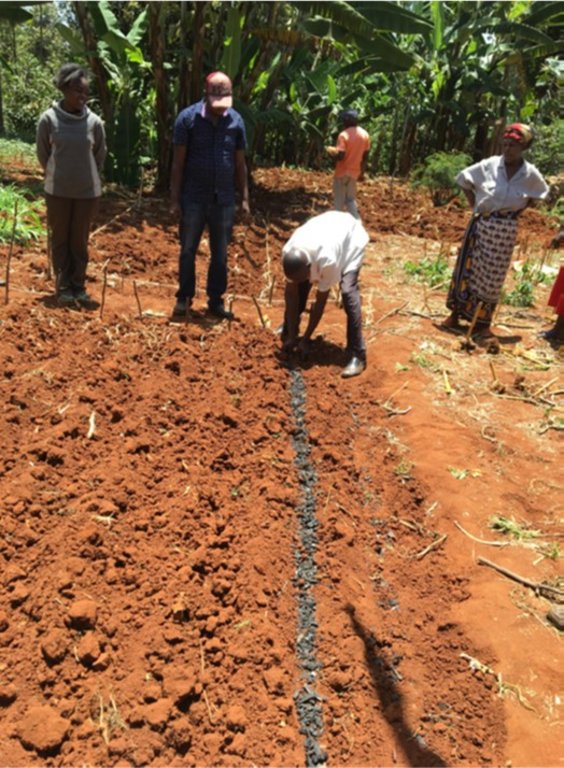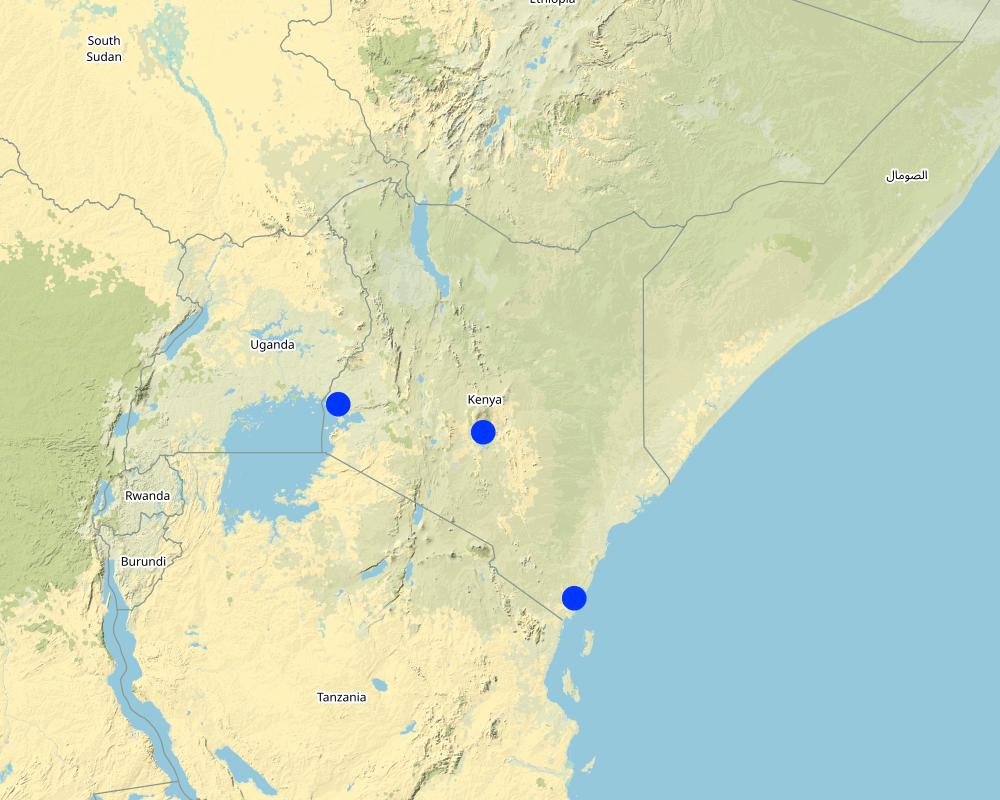Biochar application by smallholder farmers [ເຄັນຢາ]
- ການສ້າງ:
- ປັບປູງ:
- ຜູ້ສັງລວມຂໍ້ມູນ: Niels Thevs
- ບັນນາທິການ: Dries Roobroeck
- ຜູ້ທົບທວນຄືນ: William Critchley, Rima Mekdaschi Studer
technologies_6349 - ເຄັນຢາ
ເບິ່ງພາກສ່ວນ
ຂະຫຍາຍທັງໝົດ ຍຸບທັງໝົດ1. ຂໍ້ມູນທົ່ວໄປ
1.2 ຂໍ້ມູນ ການຕິດຕໍ່ພົວພັນ ຂອງບຸກຄົນທີ່ສໍາຄັນ ແລະ ສະຖາບັນ ທີ່ມີສ່ວນຮ່ວມ ໃນການປະເມີນເອກກະສານ ເຕັກໂນໂລຢີ
co-compiler:
co-compiler:
Roebroock Dries
IITA
ເຄັນຢາ
ຊື່ສະຖາບັນ (ຫຼາຍສະຖາບັນ) ທີ່ອໍານວຍຄວາມສະດວກ ໃນການສ້າງເອກກະສານ / ປະເມີນ ເຕັກໂນໂລຢີ (ຖ້າກ່ຽວຂ້ອງ)
Deutsche Gesellschaft für Internationale Zusammenarbeit (GIZ) GmbH (GIZ) - ເຢຍລະມັນ1.3 ເງື່ອນໄຂ ກ່ຽວກັບ ການນໍາໃຊ້ຂໍ້ມູນເອກະສານ ທີ່ສ້າງຂື້ນ ໂດຍຜ່ານ ອົງການພາບລວມຂອງໂລກ ທາງດ້ານແນວທາງ ແລະ ເຕັກໂນໂລຢີ ຂອງການອານຸລັກ ທໍາມະຊາດ (WOCAT)
ຜູ້ປ້ອນຂໍ້ມູນ ແລະ ບຸກຄົນສຳຄັນ ທີ່ໃຫ້ຂໍ້ມູນ (ຫຼາຍ) ຍິນຍອມ ຕາມເງື່ອນໄຂ ໃນການນຳໃຊ້ຂໍ້ມູນ ເພື່ອສ້າງເປັນເອກກະສານຂອງ WOCAT:
ແມ່ນ
1.4 ແຈ້ງການວ່າ ດ້ວຍຄວາມຍືນຍົງຂອງ ເຕັກໂນໂລຢີ
ການນໍາໃຊ້ ເຕັກໂນໂລຢີ ດັ່ງກ່າວໄດ້ອະທິບາຍ ເຖິງບັນຫາ ກ່ຽວກັບ ການເຊື່ອມໂຊມຂອງດິນບໍ? ຖ້າບໍ່ດັ່ງນັ້ນ ມັນບໍ່ສາມາດ ຢັ້ງຢືນໄດ້ວ່າ ເປັນເຕັກໂນໂລຊີ ໃນການຄຸ້ມຄອງ ທີ່ດິນແບບຍືນຍົງ? :
ບໍ່ແມ່ນ
2. ການອະທິບາຍ ເຕັກໂນໂລຢີ ຂອງການຄຸ້ມຄອງ ທີ່ດິນແບບຍືນຍົງ
2.1 ຄໍາອະທິບາຍສັ້ນຂອງ ເຕັກໂນໂລຢີ
ການກຳໜົດຄວາມໝາຍ ຂອງເຕັກໂນໂລຢີ:
Application of biochar to soils in the tropics / sub-tropics improves their ability to store and supply nutrients and water for crop growth, thereby enhancing yields and food security. At the same time, biochar holds carbon in soils for extended time periods, which makes it an agricultural practice that contributes to climate change mitigation.
2.2 ການອະທິບາຍ ລາຍລະອຽດ ຂອງເຕັກໂນໂລຢີ
ການພັນລະນາ:
Biochar is carbonised organic material that is produced through pyrolysis, that is thermal conversion under low or no oxygen. The biochar is used as an amendment to farmland for ameliorating soil properties. Owing to the great number of micropores and charges on biochar, its application to soil boosts water and nutrient storage, and their delivery to crops. Biochar also helps neutralise acidity in soils, replacing the need for lime. All these positive effects make it ideally suited for acid, nutrient-poor soils in tropical/ sub-tropical regions. Even at low rates of 1 or 2 tonnes per hectare, biochar significantly increases crop production. Biochar hardly decomposes in soils, causing positive effects to last for several years without repeat application. This also provides very stable carbon storage on farms which helps mitigate climate change. Its stability also allows farmers to gradually add biochar to the entire farm, thereby increasing their food self-sufficiency and incomes.
Biochar itself is not a fertilizer, but a soil rejuvenating agent. Therefore, farmers must apply essential nutrients through synthetic or organic inputs to reap the full yield potential and maintain soil fertility. Yet, when biochar is combined with fertilizers, about 40% - 70% nitrogen and phosphorus can be saved over multiple seasons while maintaining the same productivity. Biochar is a promising solution to address low response of crops to fertilizer addition in tropical soils and to alleviate the impact of input price hikes and supply disruptions.
In the study presented here, farmers produced biochar as a residue from small gasifier stoves during daily cooking. These systems are highly energy efficient and reduce the consumption of firewood while improving indoor air quality, which, alongside crop yield gains from biochar, is perceived positively by farmers. The specific design of gasifier stoves requires them to be well-packed with appropriately sized tree prunings or maize stems. For larger meals it requires a refill, which users find less convenient than their traditional open combustion fires. Life-cycle assessment shows that households significantly reduce greenhouse gas emissions with the gasifier stoves when biochar is applied to the farm. For the field trials with maize and kale in this study, farmers applied their usual rates of inorganic fertilizers, animal manure, or a combination of both. Results from this multi-locational participatory assessment showed that maize grain yield increased by 0.2 - 0.7 tonnes per hectare for every tonne of home-made biochar that was added to the field.
One household can produce 300 kg biochar per year by cooking on the gasifier stove. With this amount a biochar dosage of 1.5 t/ha can be realized on an area of 0.2 ha per year. If biochar is not spread evenly, but along seed rows, its effective dosage can be increased. As the gasifier stove can be operated for 2-3 years, it is assumed that the costs of 50 USD, which are needed to purchase one gasifier, are good to equip 1 ha of land with an amount of biochar that results in increased crop yields.
2.3 ຮູບພາບຂອງເຕັກໂນໂລຢີ
ຂໍ້ສັງເກດທົ່ວໄປທີ່ກ່ຽວກັບຮູບພາບ:
Both photographs were taken from the publication: Njenga M, Sundberg C, Gitau JK, Mahmoud Y, Röing de Nowina K, Mendum R and Karltun E 2020. Biochar stoves for socio-ecological resilience: Lessons from small-scale farms in rural Kenya. Policy Brief No 51. Nairobi, Kenya. World Agroforestry (ICRAF)
2.5 ປະເທດ / ເຂດ / ສະຖານທີ່ບ່ອນທີ່ ເຕັກໂນໂລຢີ ໄດ້ຮັບການນໍາໃຊ້ ແລະ ທີ່ຖືກປົກຄຸມດ້ວຍການປະເມີນຜົນ
ປະເທດ:
ເຄັນຢາ
ພາກພື້ນ / ລັດ / ແຂວງ:
Embu County, Kwale County, Siaya County
ໃຫ້ລະບຸ ການແຜ່ຂະຫຍາຍ ເຕັກໂນໂລຢີ:
- ນໍາໃຊ້ໃນຈຸດສະເພາະ / ແນໃສ່ນໍາໃຊ້ໃນພື້ນທີ່ຂະໜາດນ້ອຍ
ສ່ວນຫຼາຍສະຖານທີ່ຕັ້ງຂອງເຕັກໂນໂລຢີ ແມ່ນ ຢູ່ໃນເຂດພື້ນທີ່ສະຫງວນບໍ?
ບໍ່ແມ່ນ
Map
×2.6 ວັນທີໃນການຈັດຕັ້ງປະຕິບັດ
ໃຫ້ລະບຸປີ ໃນການຈັດຕັ້ງປະຕິບັດ:
2016
2.7 ການນໍາສະເໜີ ເຕັກໂນໂລຢີ
ໃຫ້ລະບຸ ເຕັກໂນໂລຢີ ໄດ້ຖືກຈັດຕັ້ງປະຕິບັດຄືແນວໃດ?
- ໃນໄລຍະການທົດລອງ / ການຄົ້ນຄວ້າ
ຄວາມຄິດເຫັນ (ປະເພດ ໂຄງການ ແລະ ອື່ນໆ):
IITA (International Institute of Tropical Agriculture) started a long-term field trial in 2006, in which crop and soil properties were monitored following one initial biochar application of 100 t/ha. ICRAF investigated the charcoal value chain in Kenya and, among others, promoted cooking stoves which were more efficient than the traditionally used open fires. Those stoves run on pyrolysis, which provides heat for cooking and charcoal as a residual. That charcoal can be used for cooking so that the initial biomass is used more efficiently as an energy source. Or, alternatively, the residual charcoal is used as biochar to improve the farmers' soils.
This combination of cooking and biochar production and application to soils began in 2016 as participatory research.
3. ການໃຈ້ແຍກ ເຕັກໂນໂລຢີ ໃນການຄຸ້ມຄອງ ດິນແບບຍືນຍົງ
3.1 ຈຸດປະສົງຫຼັກ (ຫຼາຍ) ຂອງເຕັກໂນໂລຢີ
- ປັບປຸງ ການຜະລິດ
- ປັບຕົວຕໍ່ກັບການປ່ຽນແປງດິນຟ້າອາກາດ / ທີ່ຮ້າຍແຮງ ແລະ ຜົນກະທົບ
- ຫຼຸດຜ່ອນຜົນກະທົບ ຈາກການປ່ຽນແປງດິນຟ້າອາກາດ
- ສ້າງຜົນກະທົບ ທາງເສດຖະກິດ ທີ່ເປັນປະໂຫຍດ
- ສ້າງຜົນກະທົບ ທີ່ເປັນທາງບວກ ໃຫ້ແກ່ສັງຄົມ
3.2 ປະເພດການນໍາໃຊ້ທີ່ດິນ ໃນປະຈຸບັນ() ທີ່ເຕັກໂນໂລຢີ ໄດ້ຖືກນໍາໃຊ້
ການນຳໃຊ້ທີ່ດິນ ປະສົມພາຍໃນພື້ນທີ່ດຽວກັນ:
ບໍ່ແມ່ນ

ດິນທີ່ປູກພືດ
- ການປູກພືດປະຈໍາປີ
ການປູກພືດປະຈຳປີ - ລະບຸປະເພດພືດ:
- ທັນຍາພືດ-ສາລີ
- ຜັກ-ຜັກໃບ( ຜັກສະລັດ, ຜັກກະລຳ, ຜັກຫົມ, ອື່ນໆ)
ຈໍານວນ ລະດູການ ປູກໃນປີໜຶ່ງ:
- 2
ລະບຸ ຊະນິດ:
2 seasons in Embu and Siaya, 1 season in Kwale
ມີການເຝືກປູກພືດແບບສັບຫວ່າງບໍ່?
ແມ່ນ
ຖ້າມີ, ໃຫ້ລະບຸວ່າປູກພືດຊະນິດໃດທີ່ປູກສັບຫວ່າງ:
Part of the households intercrop maize with beans.
ມີການເຝືກປູກພືດແບບໝູນວຽນບໍ່?
ບໍ່ແມ່ນ
3.3 ການນຳໃຊ້ທີ່ດິນ ມີການປ່ຽນແປງຍ້ອນການຈັດຕັ້ງທົດລອງເຕັກໂນໂລຢີ ແມ່ນບໍ່?
ການນຳໃຊ້ທີ່ດິນ ມີການປ່ຽນແປງຍ້ອນການຈັດຕັ້ງທົດລອງເຕັກໂນໂລຢີ ແມ່ນບໍ່?
- ບໍ່ (ຕໍ່ເໜືອງກັບ ຄຳຖາມ 3.4)

ດິນທີ່ປູກພືດ
- ການປູກພືດປະຈໍາປີ
ການປູກພືດປະຈຳປີ - ລະບຸປະເພດພືດ:
- ທັນຍາພືດ-ສາລີ
ມີການເຝືກປູກພືດແບບສັບຫວ່າງບໍ່?
ແມ່ນ
ຖ້າມີ, ໃຫ້ລະບຸວ່າປູກພືດຊະນິດໃດທີ່ປູກສັບຫວ່າງ:
maize and beans
ມີການເຝືກປູກພືດແບບໝູນວຽນບໍ່?
ບໍ່ແມ່ນ
3.4 ການສະໜອງນ້ຳ
ການສະໜອງນໍ້າ ໃນພື້ນທີ່ ທີ່ໄດ້ນໍາໃຊ້ ເຕັກໂນໂລຢີ:
- ນໍ້າຝົນ
3.5 ການນໍາໃຊ້ເຕັກໂນໂລຢີ ທີ່ຢູ່ໃນກຸ່ມການຄຸ້ມຄອງ ທີ່ດິນແບບຍືນຍົງ
- ການຈັດການອຸດົມສົມບູນ ຂອງດິນປະສົມປະສານ
3.6 ມາດຕະການ ການຄຸ້ມຄອງ ທີ່ດິນແບບຍືນຍົງ ປະກອບດ້ວຍ ເຕັກໂນໂລຢີ

ມາດຕະການ ທາງການກະສິກໍາ
- A2: ອິນຊີວັດຖຸ ຫຼື ຄວາມອຸດົມສົມບູນໃນດິນ
3.7 ປະເພດດິນເຊື່ອມໂຊມ ຫຼັກທີ່ໄດ້ນໍາໃຊ້ ເຕັກໂນໂລຢີ

ການເຊື່ອມໂຊມ ຂອງດິນ ທາງເຄມີ
- Cn: ຄວາມອຸດົມສົມບູນ ລົດໜ້ອຍຖອຍລົງ ແລະ ສານອິນຊີວັດຖຸລົດລົງ (ບໍ່ແມ່ນສາເຫດມາຈາກການເຊາະເຈື່ອນ)
- Ca: ຄວາມເປັນກົດ

ການເຊື່ອມໂຊມ ຂອງດິນ ທາງກາຍະພາບ
- Pc: ການອັດແໜ້ນ
- Pi: ເນື້ອດິນ ທີ່ມີຂະໜາດນ້ອຍຫຼາຍ
ຄວາມຄິດເຫັນ:
Biochar increases the cation exchange capacity of soils and enhances the plant availability of phosphorus so that it contributes to soil fertility. Biochar increases the soil pH so that it treats acidification of soils. In the field of soil physical properties, biochar decreases the bulk density of soils and adds pore space to soils so that the infiltration into the soil and the usable field capacity of soils are increased. In this specific case, soil sealing and compaction do not play a role, but biochar can address those soil degradation issues.
3.8 ການປ້ອງກັນ, ການຫຼຸດຜ່ອນ, ຫຼືການຟື້ນຟູຂອງການເຊື່ອມໂຊມຂອງດິນ
ໃຫ້ລະບຸ ເປົ້າໝາຍ ເຕັກໂນໂລຢີ ທີ່ພົວພັນ ກັບຄວາມເຊື່ອມໂຊມຂອງດິນ:
- ຫຼຸດຜ່ອນການເຊື່ອມໂຊມຂອງດິນ
- ການຟື້ນຟູ / ຟື້ນຟູດິນທີ່ຊຸດໂຊມ
4. ຂໍ້ກໍາໜົດ, ກິດຈະກໍາການປະຕິບັດ, ວັດຖຸດິບ, ແລະຄ່າໃຊ້ຈ່າຍ
4.2 ຂໍ້ມູນທົ່ວໄປກ່ຽວກັບການຄິດໄລ່ປັດໃຈຂາເຂົ້າໃນການຜະລິດ ແລະ ມູນຄ່າອື່ນໆ
ລະບຸ ວິທີການ ຄຳໃຊ້ຈ່າຍ ແລະ ປັດໄຈນໍາເຂົ້າ ທີ່ໄດ້ຄິດໄລ່:
- ຕໍ່ຫົວໜ່ວຍ ທີ່ໄດ້ຈັດຕັ້ງປະຕິບັດ ເຕັກໂນໂລຢີ
ໃຫ້ລະບຸຫົວໜ່ວຍ:
one gasifier cooking stove and the resulting amount of biochar
ລະບຸ ສະກຸນເງິນທີ່ໃຊ້ສໍາລັບ ການຄິດໄລ່ຄ່າໃຊ້ຈ່າຍ:
- USA
4.3 ການສ້າງຕັ້ງກິດຈະກໍາ
| ກິດຈະກໍາ | Timing (season) | |
|---|---|---|
| 1. | Biochar production | Year-round while using the gasifier cooking stove. |
| 2. | Mixing biochar into the soil | During the normal time of field preparation for and planting of the next crop |
| 3. | Proceed with normal cropping activities |
ຄວາມຄິດເຫັນ:
This SLM technique adds biochar to the ongoing cropping activities. So, the choice of crops, soil preparation, planting, inputs, and harvest do not change after biochar application. The biochar is sourced from so-called gasifier cooking stoves, which are stoves that perform through pyrolysis. The excess energy of that pyrolysis is used for cooking, while the residual char is applied as biochar to the farmers' field. Char (biochar) is produced during every cooking activity, collected, and finally applied. Most household in the project regions use open three-stone fires for cooking followed by charcoal. Adoption of the gasifier stoves is a shift away from the open fires and charcoal.
4.4 ຕົ້ນທຶນ ແລະ ປັດໄຈຂາເຂົ້າທີ່ຈໍາເປັນໃນຈັດຕັ້ງປະຕິບັດ
| ລະບຸ ປັດໃຈ ນໍາເຂົ້າ ໃນການຜະລີດ | ຫົວໜ່ວຍ | ປະລິມານ | ຕົ້ນທຶນ ຕໍ່ຫົວໜ່ວຍ | ຕົ້ນທຶນທັງໝົດ ຂອງປັດໃຈຂາເຂົ້າ ໃນການຜະລິດ | % ຂອງຕົ້ນທຶນທັງໝົດ ທີ່ຜູ້ນໍາໃຊ້ທີ່ດິນ ໃຊ້ຈ່າຍເອງ | |
|---|---|---|---|---|---|---|
| ແຮງງານ | gasifier cooking stove | 1.0 | 50.0 | 50.0 | ||
| ຕົ້ນທຶນທັງໝົດ ໃນການຈັດຕັ້ງປະຕິບັດ ເຕັກໂນໂລຢີ | 50.0 | |||||
| ຄ່າໃຊ້ຈ່າຍທັງໝົດ ສຳລັບການສ້າງຕັ້ງເຕັກໂນໂລຢີ ເປັນສະກຸນເງີນໂດລາ | 50.0 | |||||
ຄວາມຄິດເຫັນ:
As costs we only listed the 50 USD per gasifier cooking stove. As the other farm operations do not change, no further costs for plant materials or fertilizers or other were listed, because those inputs do not change solely due to the use of biochar from the gasifier stoves.
One household can produce 300 kg biochar per year by cooking on the gasifier stove. With this amount a biochar dosage of 1.5 t/ha can be realized on an area of 0.2 ha per year. If biochar is not spread evenly, but along seed rows, its effective dosage can be increased. As the gasifier stove can be operated for 2-3 years, it is assumed that the costs of 50 USD are good to equip 1 ha of land with an amount of biochar that results in increased crop yields.
4.5 ບໍາລຸງຮັກສາ / ແຜນຈັດຕັ້ງປະຕິບັດ ກິດຈະກໍາ
| ກິດຈະກໍາ | ໄລຍະເວລາ / ຄວາມຖີ່ | |
|---|---|---|
| 1. | Replace the gasifier cooking stove | every three years |
ຄວາມຄິດເຫັນ:
Once biochar has been applied into a given soil, it sits there in the soil and does not require further maintenance. The farming activities and their associated labor remain unchanged compared to the the time before biochar application.
4.6 ຄ່າໃຊ້ຈ່າຍ ແລະ ປັດໄຈນໍາເຂົ້າທີ່ຈໍາເປັນສໍາລັບການບໍາລຸງຮັກສາກິດຈະກໍາ / ແຜນປະຕິບັດ (ຕໍ່ປີ)
| ລະບຸ ປັດໃຈ ນໍາເຂົ້າ ໃນການຜະລີດ | ຫົວໜ່ວຍ | ປະລິມານ | ຕົ້ນທຶນ ຕໍ່ຫົວໜ່ວຍ | ຕົ້ນທຶນທັງໝົດ ຂອງປັດໃຈຂາເຂົ້າ ໃນການຜະລິດ | % ຂອງຕົ້ນທຶນທັງໝົດ ທີ່ຜູ້ນໍາໃຊ້ທີ່ດິນ ໃຊ້ຈ່າຍເອງ | |
|---|---|---|---|---|---|---|
| ອຸປະກອນ | gasifier cooking stove | 1 | 0.33 | 50.0 | 16.5 | 100.0 |
| ຕົ້ນທຶນທັງໝົດ ທີ່ໃຊ້ໃນການບໍາລຸງຮັກສາ ເຕັກໂນໂລຢີ | 16.5 | |||||
| ຄ່າໃຊ້ຈ່າຍທັງໝົດ ສຳລັບການບົວລະບັດຮກສາເຕັກໂນໂລຢີ ເປັນສະກຸນເງີນໂດລາ | 16.5 | |||||
ຄວາມຄິດເຫັນ:
The depreciation of the gasifier cooking stove and the need to replace it every three years is included here unde rrecurrent costs.
4.7 ປັດໄຈ ທີ່ສໍາຄັນ ທີ່ສົ່ງຜົນກະທົບ ຕໍ່ຄ່າໃຊ້ຈ່າຍ
ໃຫ້ອະທິບາຍ ປັດໃຈ ທີ່ສົ່ງຜົນກະທົບ ຕໍ່ຕົ້ນທຶນ ໃນການຈັດຕັ້ງປະຕິບັດ:
Purchase price of the gasifier stove. Opportunity cost for collection and pre-processing of tree prunings and crop residues for the stove.
5. ສະພາບແວດລ້ອມທໍາມະຊາດ ແລະ ມະນຸດ
5.1 ອາກາດ
ປະລິມານນໍ້າຝົນປະຈໍາປີ
- < 250 ມີລິແມັດ
- 251-500 ມີລິແມັດ
- 501-750 ມີລິແມັດ
- 751-1,000 ມີລິແມັດ
- 1,001-1,500 ມີລິແມັດ
- 1,501-2,000 ມີລິແມັດ
- 2,001-3,000 ມີລິແມັດ
- 3,001-4,000 ມີລິແມັດ
- > 4,000 ມີລິແມັດ
ຂໍ້ມູນສະເພາະ / ຄວາມເຫັນກ່ຽວກັບ ປະລິມານນໍ້າຝົນ:
Embu: 1200 mm, Siaya: 1350 mm, Kwale 1050 mm
ເຂດສະພາບອາກາດກະສິກໍາ
- ເຄີ່ງຄວາມຊຸ່ມ
5.2 ພູມິປະເທດ
ຄ່າສະເລ່ຍ ຄວາມຄ້ອຍຊັນ:
- ພື້ນທີ່ຮາບພຽງ (0-2%)
- ອ່ອນ (3-5 %)
- ປານກາງ (6-10 %)
- ມ້ວນ (11-15 %)
- ເນີນ(16-30%)
- ໍຊັນ (31-60%)
- ຊັນຫຼາຍ (>60%)
ຮູບແບບຂອງດິນ:
- ພູພຽງ / ທົ່ງພຽງ
- ສັນພູ
- ເປີ້ນພູ
- ເນີນພູ
- ຕີນພູ
- ຮ່ອມພູ
ເຂດລະດັບສູງ:
- 0-100 ແມັດ a.s.l.
- 101-500 ແມັດ a.s.l.
- 501-1,000 ແມັດ a.s.l.
- 1,001-1,500 ແມັດ a.s.l.
- 1,501-2,000 ແມັດ a.s.l.
- 2,001-2,500 ແມັດ a.s.l.
- 2,501-3,000 ແມັດ a.s.l.
- 3,001-4,000 ແມັດ a.s.l.
- > 4,000 ແມັດ a.s.l.
ໃຫ້ລະບຸ ເຕັກໂນໂລຢີ ທີ່ໄດ້ຖືກນຳໃຊ້:
- ບໍ່ກ່ຽວຂ້ອງ
ຄຳເຫັນ ແລະ ຂໍ້ມູນສະເພາະ ເພີ່ມເຕີມ ກ່ຽວກັບ ພູມີປະເທດ:
Kwale: 328 m a.s.l.
Embu: 1350 m a.s.l.
5.3 ດິນ
ຄວາມເລິກ ຂອງດິນສະເລ່ຍ:
- ຕື້ນຫຼາຍ (0-20 ຊັງຕີແມັດ)
- ຕື້ນ (21-50 ຊຕມ)
- ເລີກປານກາງ (51-80 ຊຕມ)
- ເລິກ (81-120 ຊມ)
- ເລິກຫຼາຍ (> 120 cm)
ເນື້ອດິນ (ໜ້າດິນ):
- ປານກາງ (ດິນໜຽວ, ດິນໂຄນ)
ເນື້ອດິນ (ເລິກຈາກໜ້າດິນ ລົງໄປຫຼາຍກວ່າ 20 ຊັງຕິແມັດ):
- ປານກາງ (ດິນໜຽວ, ດິນໂຄນ)
ຊັ້ນອິນຊີວັດຖຸ ເທິງໜ້າດິນ:
- ປານກາງ (1-3 %)
ຖ້າເປັນໄປໄດ້ ແມ່ນໃຫ້ຕິດຄັດ ການພັນລະນາດິນ ຫຼື ຂໍ້ມູນສະເພາະຂອງດິນ, ຕົວຢ່າງ, ຄຸນລັກສະນະ ປະເພດຂອງດິນ, ຄ່າຄວາມເປັນກົດ / ເປັນດ່າງຂອງດິນ, ສານອາຫານ, ດິນເຄັມ ແລະ ອື່ນໆ.
The following information are available for two field plots out of the three counties:
Embu County: pH(H2O) - 5.01, SOC - 2.01%, sand - 21%, clay - 43.5%
Siaya County: pH(H2O) - 5.25, SOC - 1.56%, sand - 22.4%, clay - 60.1%
5.4 ມີນໍ້າ ແລະ ຄຸນນະພາບ
ການມີນໍ້າ ເທິງໜ້າດິນ:
ດີ
ຄຸນນະພາບນໍ້າ (ບໍ່ມີການບໍາບັດ):
ບໍ່ມີນໍ້າດື່ມ (ຮຽກຮ້ອງໃຫ້ມີການບຳບັດນ້ຳ)
5.6 ຄຸນລັກສະນະ ຂອງຜູ້ນໍາໃຊ້ທີ່ດິນ ທີ່ໄດ້ນໍາໃຊ້ເຕັກໂນໂລຢີ
ຢູ່ປະຈຳ ຫຼື ເຄື່ອນຍ້າຍຕະຫຼອດ:
- ບໍ່ເຄື່ອນໄຫວ
ລະບົບ ການຕະຫຼາດ ແລະ ຜົນຜະລິດ:
- ກຸ້ມຕົນເອງ (ພໍພຽງ)
ລາຍຮັບ ທີ່ບໍ່ໄດ້ມາຈາກ ການຜະລິດ ກະສິກໍາ:
- 10-50 % ຂອງລາຍຮັບທັງໝົດ
ລະດັບຄວາມຮັ່ງມີ:
- ທຸກຍາກ
ບຸກຄົນ ຫຼື ກຸ່ມ:
- ບຸກຄົນ / ຄົວເຮືອນ
ລະດັບ ການຫັນເປັນກົນຈັກ:
- ການໃຊ້ແຮງງານຄົນ
ເພດ:
- ຜູ້ຍິງ
- ຜູ້ຊາຍ
ໃຫ້ລະບຸ ຄຸນລັກສະນະ ຂອງຜູ້ນໍາໃຊ້ທີ່ດິນ:
Women and children operate the gasifier stove and therefore produce the biochar. In the field it is mainly men who mix the biochar into the soil and perform other farm operations.
5.7 ເນື້ອທີ່ສະເລ່ຍຂອງດິນ ທີ່ຜູ້ນຳໃຊ້ທີ່ດິນ ໃຊ້ເຮັດເຕັກໂນໂລຢີ
- <0.5 ເຮັກຕາ
- 0.5-1 ເຮັກຕາ
- 1-2 ເຮັກຕາ
- 2-5 ເຮັກຕາ
- 5-15 ເຮັກຕາ
- 15-50 ເຮັກຕາ
- 50-100 ເຮັກຕາ
- 100-500 ເຮັກຕາ
- 500-1,000 ເຮັກຕາ
- 1,000-10,000 ເຮັກຕາ
- > 10,000 ເຮັກຕາ
ຖືໄດ້ວ່າ ເປັນຂະໜາດນ້ອຍ, ກາງ ຫຼື ໃຫຍ່ (ອີງຕາມເງື່ອນໄຂ ສະພາບຄວາມເປັນຈິງ ຂອງທ້ອງຖີ່ນ)? :
- ຂະໜາດນ້ອຍ
ຄວາມຄິດເຫັນ:
0.5 - 2 ha
5.8 ເຈົ້າຂອງທີ່ດິນ, ສິດໃຊ້ທີ່ດິນ, ແລະ ສິດທິການນໍາໃຊ້ນໍ້າ
ເຈົ້າຂອງດິນ:
- ບຸກຄົນ, ບໍ່ມີຕໍາແໜ່ງ
- ບຸກຄົນ, ທີ່ມີຕໍາແໜ່ງ
ສິດທິ ໃນການນໍາໃຊ້ທີ່ດິນ:
- ບຸກຄົນ
ສິດທິ ໃນການນໍາໃຊ້ນໍ້າ:
- ເປີດກວ້າງ (ບໍ່ມີການຈັດຕັ້ງ)
ສິດນຳໃຊ້ທີ່ດິນ ແມ່ນ ອີງໃສ່ລະບົບກົດໝາຍແບບດັ້ງເດີມບໍ?
ແມ່ນ
5.9 ການເຂົ້າເຖິງການບໍລິການ ແລະ ພື້ນຖານໂຄງລ່າງ
ສຸຂະພາບ:
- ທຸກຍາກ
- ປານກາງ
- ດີ
ການສຶກສາ:
- ທຸກຍາກ
- ປານກາງ
- ດີ
ການຊ່ວຍເຫຼືອ ດ້ານວິຊາການ:
- ທຸກຍາກ
- ປານກາງ
- ດີ
ການຈ້າງງານ (ຕົວຢ່າງ, ການເຮັດກິດຈະກໍາອື່ນ ທີ່ບໍ່ແມ່ນ ການຜະລິດກະສິກໍາ):
- ທຸກຍາກ
- ປານກາງ
- ດີ
ຕະຫຼາດ:
- ທຸກຍາກ
- ປານກາງ
- ດີ
ພະລັງງານ:
- ທຸກຍາກ
- ປານກາງ
- ດີ
ຖະໜົນຫົນທາງ ແລະ ການຂົນສົ່ງ:
- ທຸກຍາກ
- ປານກາງ
- ດີ
ການດື່ມນໍ້າ ແລະ ສຸຂາພິບານ:
- ທຸກຍາກ
- ປານກາງ
- ດີ
ການບໍລິການ ທາງດ້ານການເງິນ:
- ທຸກຍາກ
- ປານກາງ
- ດີ
6. ຜົນກະທົບ ແລະ ລາຍງານສະຫຼຸບ
6.1 ການສະແດງຜົນກະທົບ ພາຍໃນພື້ນທີ່ ທີ່ໄດ້ຈັດຕັ້ງປະຕິບັດ ເຕັກໂນໂລຢີ
ຜົນກະທົບທາງເສດຖະກິດສັງຄົມ
ການຜະລິດ
ການຜະລິດພືດ
ປະລິມານ ກ່ອນການຈັດຕັ້ງປະຕິບັດ ການຄຸ້ມຄອງ ທີ່ດິນແບບຍືນຍົງ:
0,9 Mg/ha
ປະລີມານ ຫຼັງການຈັດຕັ້ງປະຕິບັດ ການຄຸ້ມຄອງ ທີ່ດິນແບບຍືນຍົງ:
4.4 Mg/ha
ຄວາມຄິດເຫັນ / ລະບຸແຈ້ງ:
- Range of maize: from 0,9 Mg/ha (control) to 4.4 Mg/ha (biochar plot) and average increase of 33% in kale yields (on 68% of the farms) in experiment where farmers used their own biochar.
- in longterm experiment with higher amounts of biochar a yield increase of 84% was observed
-
ລາຍໄດ້ ແລະ ຄ່າໃຊ້ຈ່າຍ
ຄວາມຫຼາກຫຼາຍ ຂອງແຫຼ່ງລາຍຮັບ
ຄວາມຄິດເຫັນ / ລະບຸແຈ້ງ:
20-40% of firewood could be saved by using the biochar gasifiers instead of traditional cooking stoves. This reduces costs and work load for households.
ຜົນກະທົບຕໍ່ລະບົບນິເວດ
ການຫຼຸດຜ່ອນ ຄວາມສ່ຽງ ຈາກໄພພິບັດ ແລະ ອາກາດປ່ຽນແປງ
ການລະເຫີຍອາຍກາກບອນ ແລະ ອາຍຜິດເຮືອນແກ້ວ
ຄວາມຄິດເຫັນ / ລະບຸແຈ້ງ:
54 to 100% plus net carbon sequestration.
6.2 ຜົນກະທົບທາງອ້ອມ ຈາກການນໍາໃຊ້ເຕັກໂນໂລຢີ
ຜົນກະທົບ ຂອງອາຍຜິດເຮືອນແກ້ວ
ຄວາມຄິດເຫັນ / ລະບຸແຈ້ງ:
Due to reduced demand for fuel wood, this SLM technology reduces forest degradation and associated greenhouse gas emissions.
6.4 ການວິເຄາະຕົ້ນທຶນ ແລະ ຜົນປະໂຫຍດ
ຈະເຮັດປະໂຫຍດເພື່ອປຽບທຽບກັບຄ່າໃຊ້ຈ່າຍກັບສິ່ງກໍ່ສ້າງ (ຈາກທັດສະນະຂອງຜູ້ນຳໃຊ້ທີ່ດິນ) ໄດ້ແນວໃດ?
ຜົນຕອບແທນ ໃນໄລຍະສັ້ນ:
ຜົນກະທົບທາງບວກ
ຜົນຕອບແທນ ໃນໄລຍະຍາວ:
ຜົນກະທົບທາງບວກ
ຈະໄດ້ຮັບຜົນປະໂຫຍດເມື່ອປຽບທຽບກັບ / ຄ່າໃຊ້ຈ່າຍໃນການບຳລຸງຮັກສາທີເ່ກີດຂື້ນອິກ (ຈາກທັດສະນະຄະຕິຂອງຜູ້ນຳໃຊ້ທີ່ດິນ) ໄດ້ແນວໃດ?
ຜົນຕອບແທນ ໃນໄລຍະສັ້ນ:
ຜົນກະທົບທາງບວກ
ຜົນຕອບແທນ ໃນໄລຍະຍາວ:
ຜົນກະທົບທາງບວກ
ຄວາມຄິດເຫັນ:
The main benefits from this SLM technology from the land users' perspective are increased crop yields, reduced need to collect fuel wood, and improved indoor ambient air quality. The latter two benefits materialize immediately, onec the gasifier is used. The crop yields increase during the season that follows the biochar application, which is a short-term benefit. These benefits justify the establishment costs, which in fact are the costs to purchase the gasifier.
On a long-term perspective, the effect to improve the soil, which leads to crop yield increases, remains, because biochar is stable in soils ove rlong time periods. Particularly positive is that there are no maintenence costs to keep the biochar in the soil.
6.5 ການປັບຕົວຮັບເອົາເຕັກໂນໂລຢີ
- ກໍລະນີດຽວ / ການທົດລອງ
ທັງໝົດນັ້ນ ແມ່ນໃຜ ໄດ້ປັບຕົວເຂົ້າ ໃນການນໍາໃຊ້ ເຕັກໂນໂລຢີ, ມີຈັກຄົນ ທີ່ສາມາດເຮັດເອງໄດ້, ຕົວຢ່າງ, ປາດສະຈາກ ການຊ່ວຍເຫຼືອ ທາງດ້ານອຸປະກອນ / ການຈ່າຍເປັນເງິນ?
- 0-10%
6.6 ການປັບຕົວ
ໄດ້ມີການດັດປັບ ເຕັກໂນໂລຢີ ເພື່ອໃຫ້ແທດເໝາະກັບເງື່ອນໄຂ ການປ່ຽນແປງບໍ?
ບໍ່ແມ່ນ
6.7 ຈຸດແຂງ / ຂໍ້ດີ / ໂອກາດ ໃນການນໍາໃຊ້ ເຕັກໂນໂລຢີ
| ຈຸດແຂງ / ຂໍ້ດີ / ໂອກາດໃນການນໍາໃຊ້ທີ່ດິນ |
|---|
| Most land users stated to have observed positive impacts on soil health and improvement of soil fertility. Additionally, about 25% of the land users specifically mentioned that the moisture retention in the soil improved after biochar application. Some land users experienced lower costs for fertilizers. |
|
Most land users found the small top-lit updraft cooking stoves are easy to use, though being more suitable for food with short cooking time. All land users stated that the gasifier cooking stoves were cleaner than the traditional open fires and charcoal stoves, since the gasifiers produced less smoke, less soot, and fewer ashes. Some land users responded even that the gasifiers were less harmful to cooking utensils and food tasted better (less smoky). The gasifier stove was preferred by land users because it takes less fuel and therefore saves time to collect fire wood and household expenditures. This was particularly viewed positively by women. The residual char also can be used as an energy source. Some land users saw sales of charcoal as potential additional income. |
| In total, the package of using gasifier stoves for cooking and applying the residual biochar to soils was seen as beneficial by most land users, because it saved costs and efforts on the side of cooking and increased crop yields and income. |
| ຈຸດແຂງ / ຈຸດດີ / ໂອກາດ ຈາກທັດສະນະຂອງຜູ້ປ້ອນຂໍ້ມູນ ຫຼື ບຸກຄົນສຳຄັນ |
|---|
|
Biochar improves soil properties which intensifies crop production. Even a small amount of biochar added to the soil has a long-lasting positive effect on yields. The effect of a one-time biochar application lasts for decades. Therefore, if soils are enriched with biochar by repeatedly adding low quantities, its benefits to land users accumulate over time. Biochar increases the cation exchange capacity, pH, and phosphorus availability of soils, which are key constraints to in many farming systems across tropical Africa. Non-responsive soils are turned into soils that respond to fertilizer application. |
6.8 ຈຸດອ່ອນ / ຂໍ້ເສຍ / ຄວາມສ່ຽງ ໃນການນໍາໃຊ້ ເຕັກໂນໂລຢີ ແລະ ວິທີການແກ້ໄຂບັນຫາ
| ຈຸດອ່ອນ / ຂໍ້ເສຍ / ຄວາມສ່ຽງໃນມຸມມອງຂອງຜູ້ນໍາໃຊ້ທີ່ດິນ | ມີວິທີການແກ້ໄຂຄືແນວໃດ? |
|---|---|
| Half of the respondents stated the production of biochar was time consuming due to the process of cutting the feedstock in suitable sizes, as needed for the gasifier stove. | Chopped firewood for the gasifier could become a source of income for youth. |
| ຈຸດອ່ອນ/ຂໍ້ບົກຜ່ອງ/ຄວາມສ່ຽງ ຈາກທັດສະນະຂອງຜູ້ປ້ອນຂໍ້ມູນ ຫຼື ບຸກຄົນສຳຄັນ | ມີວິທີການແກ້ໄຂຄືແນວໃດ? |
|---|---|
| Gasifiers may emit more methane than technologically more advanced pyrolysis units. |
Improve the gasifier utility with a shift to the latest mobile or decentralized technologies that produce syngas, green hydrogen or electricity that can be used for cooking. |
| Deploying gasifier and biochar at large scale without regulations poses a risk of unsustainable rates of tree clearing and residue removal. | Follow rules such as EBC and only use on-farm or residual biomass. |
7. ເອກະສານອ້າງອີງ ແລະ ການເຊື່ອມຕໍ່
7.1 ວິທີການ / ແຫຼ່ງຂໍ້ມູນ
- ການໄປຢ້ຽມຢາມພາກສະໜາມ, ການສໍາຫຼວດພາກສະໜາມ
Field surveys took place within different research works, which were published in peer-reviewed papers.
- ການສໍາພາດ ຜູ້ນໍາໃຊ້ທີ່ດິນ
Interviews with land users took place within different research works, which were published in peer-reviewed papers.
- ການລວບລວມ ບົດລາຍງານ ແລະ ເອກະສານ ອື່ນໆ ທີ່ມີຢູ່ແລ້ວ
The information was compiled from peer-reviewed papers and exchange with the authors of those papers.
ຄວາມຄິດເຫັນ:
The study was conducted between 2013 and 2019 and results of different work streams were published in a number of peer-reviewed papers.
7.2 ເອກກະສານອ້າງອີງທີ່ເປັນບົດລາຍງານ
ຫົວຂໍ້, ຜູ້ຂຽນ, ປີ, ISBN:
Biochar from cooking stoves reduces greenhouse gas emissions from smallholder farms in Africa; Sundberg et al., 2020
ມີຢູ່ໃສ?ມູນຄ່າເທົ່າໃດ?
https://link.springer.com/article/10.1007/s11027-020-09920-7, open access
ຫົວຂໍ້, ຜູ້ຂຽນ, ປີ, ISBN:
Use of Biochar-Producing Gasifier Cookstove Improves Energy Use Efficiency and Indoor Air Quality in Rural Households; Gitau et al., 2019
ມີຢູ່ໃສ?ມູນຄ່າເທົ່າໃດ?
https://www.mdpi.com/1996-1073/12/22/4285, open access
ຫົວຂໍ້, ຜູ້ຂຽນ, ປີ, ISBN:
Implications on Livelihoods and the Environment of Uptake of Gasifier Cook Stoves among Kenya’s Rural Households; Gitau et al., 2019
ມີຢູ່ໃສ?ມູນຄ່າເທົ່າໃດ?
https://www.mdpi.com/2076-3417/9/6/1205/pdf, open access
ຫົວຂໍ້, ຜູ້ຂຽນ, ປີ, ISBN:
Factors influencing the adoption of biochar-producing gasifier cookstoves by households in rural Kenya; Gitau et al., 2019
ມີຢູ່ໃສ?ມູນຄ່າເທົ່າໃດ?
https://www.sciencedirect.com/science/article/pii/S0973082618308913, open access
ຫົວຂໍ້, ຜູ້ຂຽນ, ປີ, ISBN:
Soils, sinks, and smallholder farmers: Examining the benefits of biochar energy transitions in Kenya; Mahmood et al., 2021
ມີຢູ່ໃສ?ມູນຄ່າເທົ່າໃດ?
https://reader.elsevier.com/reader/sd/pii/S2214629621001262?token=D446F30FC8FDAEC80F73AE31BBFEA69E754E2F9EB21A9605CC6D04A2FE0FCD39182848F88AC6D17BF7D12B8EEED7BD9E&originRegion=eu-west-1&originCreation=20210415190025, open access
ຫົວຂໍ້, ຜູ້ຂຽນ, ປີ, ISBN:
Gasifier as a cleaner cooking system in rural Kenya; Njenga et al., 2016
ມີຢູ່ໃສ?ມູນຄ່າເທົ່າໃດ?
https://www.sciencedirect.com/science/article/abs/pii/S0959652616000743?via%3Dihub, access at no costs through limited number of institutions
ຫົວຂໍ້, ຜູ້ຂຽນ, ປີ, ISBN:
Biochar addition persistently increased soil fertility and yields in maizesoybean rotations over 10 years in sub-humid regions of Kenya; Kätterer et al., 2019
ມີຢູ່ໃສ?ມູນຄ່າເທົ່າໃດ?
https://www.sciencedirect.com/science/article/pii/S0378429018318938?via%3Dihub, open access
ຫົວຂໍ້, ຜູ້ຂຽນ, ປີ, ISBN:
sMaize grain yield responses to realistic biochar application rates on smallholder farms in Kenya, Kätterer et al., 2022
ມີຢູ່ໃສ?ມູນຄ່າເທົ່າໃດ?
https://link.springer.com/article/10.1007/s13593-022-00793-5, open access
7.3 ເຊື່ອມຕໍ່ກັບຂໍ້ມູນທີ່ກ່ຽວຂ້ອງໂດຍກົງ
ຫົວຂໍ້ / ພັນລະນາ:
Biochar stoves for socio-ecological resilience: Lessons from small-scale farms in rural Kenya / Report by ICRAF
URL:
http://apps.worldagroforestry.org/downloads/Publications/PDFS/PB20040.pdf
ຂໍ້ມູນການເຊື່ອມຕໍ່ ແລະ ເນື້ອໃນ
ຂະຫຍາຍທັງໝົດ ຍຸບທັງໝົດການເຊື່ອມຕໍ່
ບໍ່ມີຂໍ້ມູນການເຊື່ອມຕໍ່
ເນື້ອໃນ
ບໍ່ມີເນື້ອໃນ


